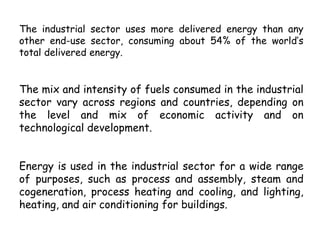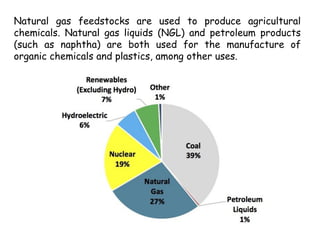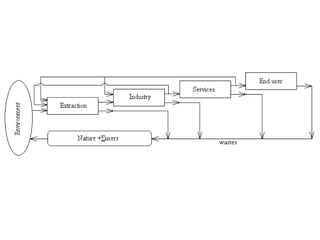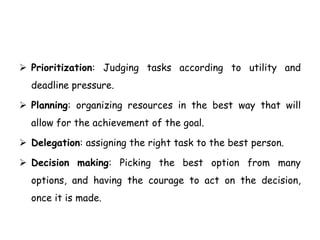Energy requirements in industry & skill power management
- 1. Energy requirements in Industry & Skill power management Dr. N. Yuvaraj Assistant Professor Achariya Arts and Science College Villianur , Puducherry
- 2. The industrial sector uses more delivered energy than any other end-use sector, consuming about 54% of the world’s total delivered energy. The mix and intensity of fuels consumed in the industrial sector vary across regions and countries, depending on the level and mix of economic activity and on technological development. Energy is used in the industrial sector for a wide range of purposes, such as process and assembly, steam and cogeneration, process heating and cooling, and lighting, heating, and air conditioning for buildings.
- 5. Natural gas feedstocks are used to produce agricultural chemicals. Natural gas liquids (NGL) and petroleum products (such as naphtha) are both used for the manufacture of organic chemicals and plastics, among other uses.
- 7. World energy sources Energy sources can be classified, in terms of the fundamental forces involved, as: Nuclear-origin sources: celestial (solar radiation), crust (fission), earth interior (geothermal). Chemical-origin sources (fuels to burn in air): biomass, and fossil fuels (from by-gone biomass). Physical-origin sources: water reservoirs, ocean currents, winds, ocean waves. Notice that thermal energy, although of a physical nature, originates from chemical and nuclear processes (e.g. from combustion, solar radiation, geothermal decay...).
- 9. World energy consumption Energy consumption is loosely correlated with gross national product (GDP), but there is a large difference even between the most highly developed countries. Care must be paid when interpreting energy management data because power installed (capability) is sometimes confused with power produced.
- 10. Electrical energy consumption has been a measure of society development, but there have already been some great failures in prospects: The ‘all-electric home’, which started in the 1920s in the USA and peaked in the 1950s worldwide. Experience has shown how expensive it can be the substitution of fuel carriers by electricity in the heating and hot water services. The ‘electricity too-cheap-to-meter’, which the nuclear power stations advocated in the 1960s.
- 12. Labour Characteristics Quality of Work - caliber of work produced or accomplished. Quantity of Work - volume of acceptable work Job Knowledge - demonstrated knowledge of requirements, methods, techniques and skills involved in doing the job and in applying these to increase productivity. Related Work Knowledge - knowledge of effects of work upon other areas and knowledge of related areas which have influence on assigned work. Judgment - soundness of conclusions, decisions and actions. Initiative - ability to take effective action without being told.
- 13. Resource Utilization - ability to delineate project needs and locate, plan and effectively use all resources available. Dependability - reliability in assuming and carrying out commitments and obligations. Analytical Ability - effectiveness in thinking through a problem and reaching sound conclusions. Communicative Ability - effectiveness in using oral and written communications and in keeping subordinates, associates, superiors and others adequately informed.
- 14. Interpersonal Skills - effectiveness in relating in an appropriate and productive manner to others. Ability to Work Under Pressure - ability to meet tight deadlines and adapt to changes. Security Sensitivity - ability to handle confidential information appropriately and to exercise care in safeguarding sensitive information. Safety Consciousness - has knowledge of good safety practices and demonstrates awareness of own personal safety and the safety of others. Profit and Cost Sensitivity - ability to seek out, generate and implement profit-making ideas.
- 15. Planning Effectiveness - ability to anticipate needs, forecast conditions, set goals and standards, plan and schedule work and measure results. Leadership - ability to develop in others the willingness and desire to work towards common objectives. Delegating - effectiveness in delegating work appropriately. Development of People - ability to select, train and appraise personnel, set standards of performance, and provide motivation to grow in their capacity and Diversity (Equal Employment Opportunity) .
- 17. Job-site labour productivity can be estimated either for each craft (carpenter, bricklayer, etc.) or each type of construction (residential housing, processing plant, etc.) under a specific set of work conditions A base labour productivity may be defined for a set of work conditions specified by the owner or contractor who wishes to observe and measure the labour performance over a period of time under such conditions A labour productivity index may then be defined as the ratio of the job-site labour productivity under a different set of work conditions to the base labour productivity, and is a measure of the relative labour efficiency of a project under this new set of work conditions.
- 18. Productivity at job site Contractors and owners are often concerned with the labor activity at job sites. For this purpose, it is convenient to express labor productivity as functional units per labor hour for each type of construction task. For example, cubic yards of concrete placed per hour is a lower level of measure than miles of highway paved per hour. Lower-level measures are more useful for monitoring individual activities, while higher-level measures may be more convenient for developing industry-wide standards of performance.
- 19. The project work conditions include the factors: Job size and complexity. Job site accessibility. Labor availability. Equipment utilization. Contractual agreements. Local climate. Local cultural characteristics, particularly in Indian operations.
- 21. Organising Work All the members of a team must work in an intelligent and integrated fashion, so that their joint effort is coordinated to achieve their joint targets That means the manager must be able to: 1. Prioritize 2. Delegate 3. Make good decisions 4. Plan ahead
- 22. Prioritization: Judging tasks according to utility and deadline pressure. Planning: organizing resources in the best way that will allow for the achievement of the goal. Delegation: assigning the right task to the best person. Decision making: Picking the best option from many options, and having the courage to act on the decision, once it is made.






















